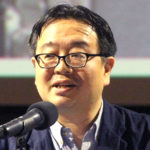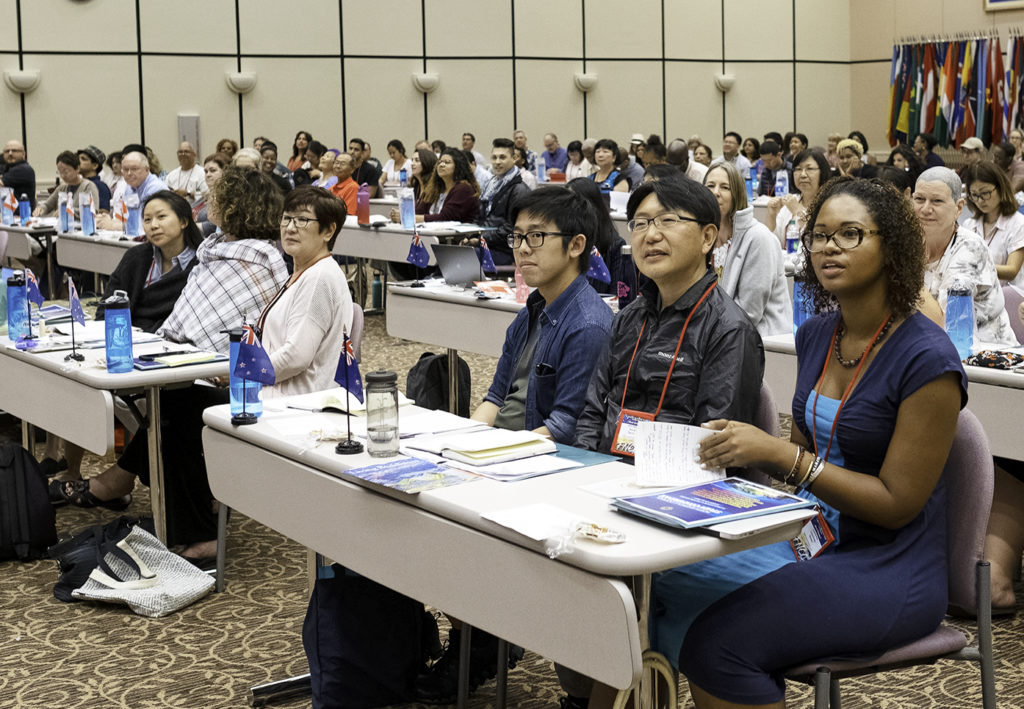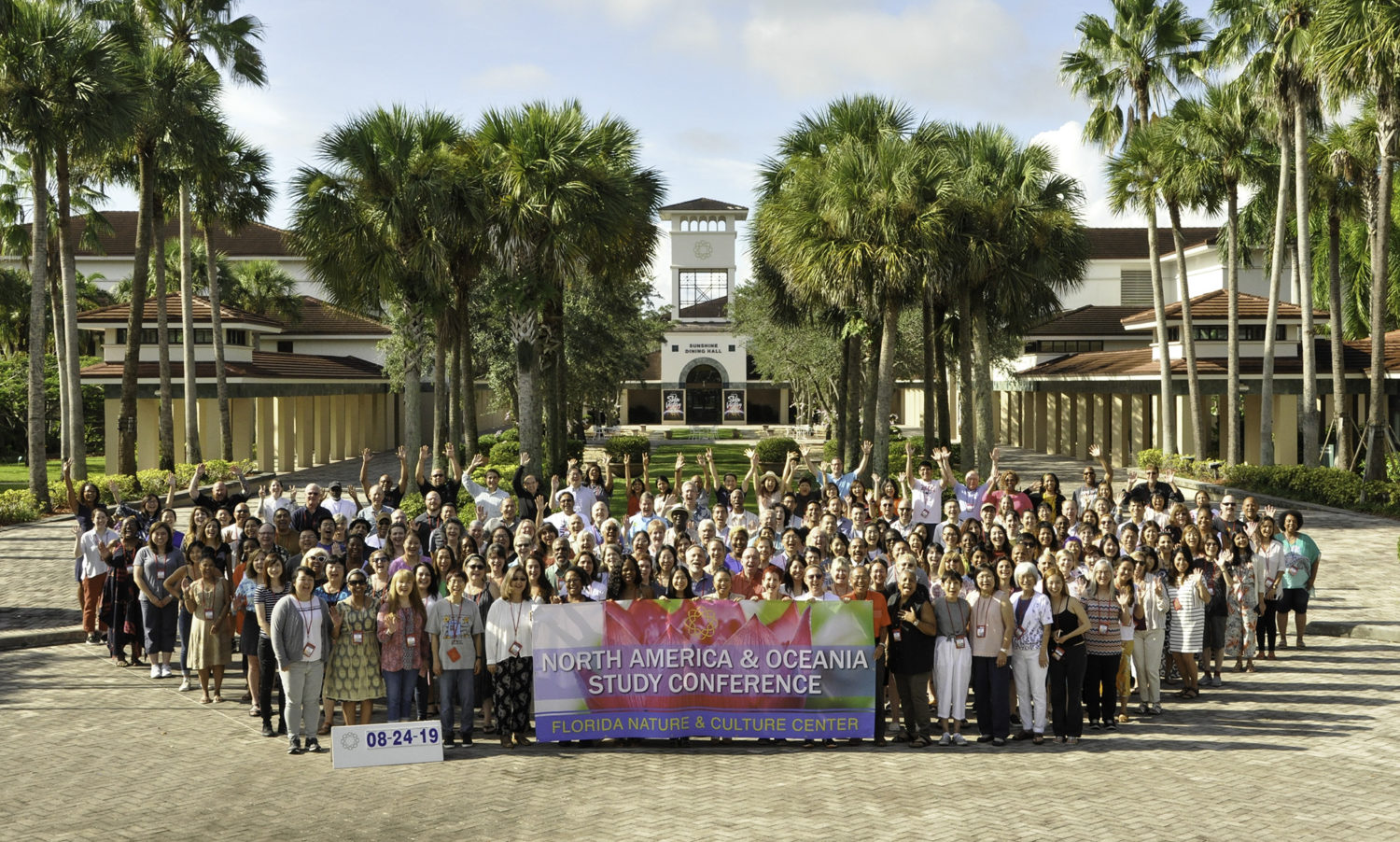
WESTON, Fla., Aug. 23–26—Why has the SGI developed so dynamically? When second Soka Gakkai President Josei Toda began his efforts to rebuild the Soka Gakkai after World War II, he did so by studying Nichiren Daishonin’s writings.
In a message to the North America and Oceania Study Conference, SGI President Ikeda noted that it is through reading Nichiren’s writings and directly connecting with his spirit that we come to strengthen, purify and deepen our faith.
“Moreover,” he continued, “as we study this foremost life philosophy, the wisdom and courage of the Buddha well forth from within us, and we awaken to our mission as Bodhisattvas of the Earth to lead humanity to happiness and bring peace to our world.”
One hundred and eighty-nine representatives from Oceania, Canada, Barbados, Jamaica and the U.S. converged on the SGI-USA Florida Nature and Culture Center during the auspicious weekend of Aug. 24— the day 72 years ago when President Ikeda joined the Soka Gakkai—to reconfirm their bodhisattva vow at a four-day study conference, led by SGI Vice Study Leader Hideyuki Takano.
During the conference, Mr. Takano lectured on the five-part sub-series “For Our Wonderful New Members” from President Ikeda’s ongoing lecture series “The Buddhism of the Sun—Illuminating the World.” (The sub-series was printed in the May–September 2019 issues of Living Buddhism.)
Mr. Takano shared that these lectures are not only relevant to new members, but also provide important points of faith for those supporting them.
On March 11, 2018, the World Youth General Meeting was held in Tokyo to commemorate the 60th anniversary of March 16, Kosen-rufu Day, the occasion when second Soka Gakkai President Josei Toda bequeathed the mission and responsibility for kosen-rufu to the youth.
Toward this commemorative event, members in Japan and throughout the world made great strides in introducing others, especially youth, to Nichiren Buddhism. SGI Vice Study Leader Hideyuki Takano shared that these earnest efforts to welcome new members and then have them take the Introductory Exam served as the impetus for SGI President Ikeda to write a five-part study series offering guidelines to new members.
Mr. Takano opened the conference by lecturing on part 1 of President Ikeda’s sub-series, which focuses on the most essential principle in Nichiren Buddhism: the oneness of mentor and disciple.
In President Ikeda’s lecture “Nichiren Buddhism Is a Teaching of Mentor and Disciple—Let’s Walk the Great Path to Happiness Together and Win!” (see May 10, 2019, World Tribune insert), he opens with these words:
Nichiren Buddhism is the supreme way to develop wisdom for achieving happiness and peace. It is a teaching that enriches each person’s life while striving at the same time to elevate the life state of humanity and create a society in which people can live together in harmony.
The Soka Gakkai is growing dynamically as a global religious movement of the 21st century. All of you, our new members who have joined us at this time of the new era of worldwide kosen-rufu, possess a mission imbued with “great good fortune from past existences” (The Lotus Sutra and Its Opening and Closing Sutras, p. 356), just as Buddhism teaches. (May 10, 2019, World Tribune, p. A)
Mr. Takano said that, while there may be many things that new members do not understand quite yet about Buddhism, each of them possesses great and unlimited potential.
Elevating the life state of disciples to the same level as the Buddha is the fundamental aim of Buddhism.
It must be ties of karma from the distant past that have destined you to become my disciple at a time like this. Shakyamuni and Many Treasures certainly realized this truth. The [Lotus Sutra’s] statement, “Those persons who had heard the Law dwelled here and there in various Buddha lands, constantly reborn in company with their teachers” [LSOC, 178], cannot be false in any way. (“The Heritage of the Ultimate Law of Life,” The Writings of Nichiren Daishonin, vol. 1, p. 217)
In his lecture, President Ikeda discussed the specifics of this letter, which was written in 1272 when Nichiren Daishonin was exiled on Sado Island and living at Tsukahara. It was addressed to his disciple Sairen-bo, who was also exiled there.
Nichiren wrote this letter in response to a question from Sairen-bo, who asked about the essential principles related to attaining Buddhahood. The above passage refers to the Buddhist view of the deep karmic ties that link mentor and disciple.
Regarding the concept of “the heritage of the ultimate Law of life,” it refers to the Buddha (or mentor) passing on the most important or essential Law for attaining Buddhahood to the people (or disciples).
In “Expedient Means,” the second chapter of the Lotus Sutra, the Buddha explains his greatest desire “to make all persons equal to me, without any distinction between us” (LSOC, 70). In other words, he wishes to enable all people to attain the same life state of Buddhahood that he had achieved.
President Ikeda underscores the distinguishing characteristic of Buddhism toward that end:
Buddhism is distinguished by the fact that it is a teaching focused on human beings. A Buddha is an awakened human being—a person, just like the rest of us. The person who is first to awaken to the Law (the Buddha) teaches that Law, seeking to elevate the lives of all human beings. In that respect, the true relationship between the Buddha and ordinary people is not like that between a god and human beings, but a relationship between teacher and student, between mentor and disciple.
People of later ages lost sight of this core message of Buddhism. One way they did so was to limit the attainment of Buddhahood to a certain time and to people of a certain capacity. Another was to turn the Buddha into a deified image, something entirely separate from human beings. The mentor-disciple relationship was completely forgotten.
The Lotus Sutra corrects this distortion. It teaches the ultimate truth of Buddhism, that all people possess the supreme state of Buddhahood within them, and describes the Buddha’s basic efforts to enable all living beings to attain a life state equal to his own. The words “to make all persons equal to me, without any distinction between us” (LSOC, 70) constitute a key sutra passage that revives the humanistic essence of Buddhism.
Elevating the life state of disciples to the same level as the Buddha—this is the fundamental aim of Buddhism and the most important theme of the Lotus Sutra. It is none other than the path of mentor and disciple, the oneness of mentor and disciple.
Precisely because it is grounded in the spirit of mentor and disciple, Nichiren Buddhism is a humanistic teaching, one in which ordinary people take the lead.(May 10, 2019, World Tribune, p. B)
Mr. Takano reiterated that the greatest feature of our practice of Nichiren Buddhism is this idea of the oneness of mentor and disciple. “Even if we are chanting the same Nam-myoho-renge-kyo, without the mentor-disciple spirit flowing through our lives, we cannot fully gain the benefit of this practice,” he said.
What’s more, the power source for transforming our karma and expanding kosen-rufu is this spirit of mentor and disciple.
Returning to “The Heritage of the Ultimate Law of Life,” Nichiren writes:
Nichiren has been trying to awaken all the people of Japan to faith in the Lotus Sutra so that they too can share the heritage [of the Law] and attain Buddhahood. (WND-1, 217)
The Daishonin, who was the Buddha of the Latter Day of the Law, awakened to the path for becoming a Buddha that Shakyamuni had expounded in the Lotus Sutra. He then stood up with a great vow to awaken all people in this troubled world to this same path.
Sairen-bo, the recipient of this letter, faced various difficulties due to the fact that he was Nichiren’s disciple. However, because he remained undefeated by such hardships, Nichiren praised this “new member” as a person of “pure gold.”
Nichiren writes:
Gold can be neither burned by fire nor corroded or swept away by water, but iron is vulnerable to both. A worthy person is like gold, a fool like iron. You are like pure gold because you embrace the “gold” of the Lotus Sutra. (WND-1, 217)
As his disciple, Sairen-bo willingly faced persecutions and obstacles as he faithfully followed the Daishonin. The passage above was Nichiren’s way of praising his disciple and teaching him that the heritage of Buddhism is passed on and validated through actions based on the spirit of the oneness of mentor and disciple.
In his lecture on “The Heritage of the Ultimate Law of Life,” President Ikeda shares the spirit of embracing the Lotus Sutra as a disciple:
Embracing the Lotus Sutra specifically means internalizing the great vow of the mentor who has dedicated his life as a votary of the Lotus Sutra and, even in times of adversity, maintaining the same resolute and selfless faith as the mentor.
In other words, a person of “pure gold” is another name for a person of selfless dedication to the Law. Such people are to be exalted, as Nichiren indicates, “If the Law that one embraces is supreme, then the person who embraces it must accordingly be foremost among all others” (“Questions and Answers about Embracing the Lotus Sutra,” WND-1, 61). (The Heritage of the Ultimate Law of Life: SGI President Ikeda’s Lecture Series, p. 86)
Mr. Takano shared that when we translate that into our own Buddhist practice, we could say that embracing the Lotus Sutra means upholding faith in the Mystic Law, which leads all people to absolute happiness. It also means taking our mentor’s great vow for kosen-rufu and making it our own as we strive to continue developing our faith.
This is why Nichiren shares with Sairen-bo, “It must be ties of karma from the distant past that have destined you to become my disciple at a time like this” (“The Heritage of the Ultimate Law of Life,” WND-1, 217).

“The thing that brings me the greatest joy is the fact that I’m able to fight alongside Sensei for the sake of kosen-rufu.”
Mr. Takano relayed the story of Takayuki Mizutani, a district young men’s leader from Kansai, whom he interviewed four years ago for the Seikyo Shimbun, the Soka Gakkai’s daily newspaper.
Mr. Mizutani had been diagnosed with terminal cancer in November 2013 at 38 years old. After surgery, doctors found that the cancer had spread to his lymph nodes and liver, giving him a 13 percent chance of survival beyond five years.
Mr. Mizutani recalled standing in the hospital parking lot sobbing, and crying out: “Why me?”
When Mr. Mizutani was 18, he had gotten into a motorcycle accident and narrowly escaped death. He married and then divorced by age 33. He had a stroke, and was then diagnosed with cardiomyopathy as well as a kidney disorder.
He overcame each illness, but was then diagnosed with cancer while working as a truck driver. “When he received word that he may not live long, he was forced to squarely face death head-on,” Mr. Takano said. “That’s when he began for the first time to truly read and re-read Sensei’s guidance, study Nichiren’s writings and deeply ponder the meaning of his life.”
During this time, he studied President Ikeda’s lecture series on “The Heritage of the Ultimate Law of Life” over and over again, engraving this passage from the Lotus Sutra in his life:
Those persons who had heard the Law dwelled here and there in various Buddha lands, constantly reborn in company with their teachers. (LSOC, 178)
Mr. Mizutani shared during the interview: “In the past, I had only been focused on ‘wanting a new bike,’ ‘making money’ or ‘having a good, comfortable life.’ But once I got sick, all those things completely lost any meaning. On the other hand, I found real joy, an undeniable joy, in using the short time I had left in life to help those who were struggling with illness and hardships, and to use my life for the sake of kosen-rufu. And as I spent each day that followed focusing on using my life for others, for some reason, each day became so full and enjoyable. And ever since my diagnosis, each word of Sensei’s guidance and each word of Nichiren’s writings just reverberated throughout my entire heart.”
The two men stayed in touch. Whatever he was going through, Mr. Mizutani would always share: “The thing that brings me the greatest joy is the fact that I’m able to fight alongside Sensei for the sake of kosen-rufu.”
Mr. Mizutani passed away in January 2016 at 40 years old, beloved by so many members. Mr. Takano said he learned from Mr. Mizutani that we can become stronger even in the face of death when we base our lives on faith. “He taught me that we must never forget to live our lives in the spirit of shared struggle with our mentor, no matter our circumstances,” Mr. Takano said.
“In the same way, countless SGI members throughout the world live with the feeling that they are always fighting alongside their mentor,” he continued. “This shared struggle of mentor and disciple is the basis for the SGI’s growth and expansion to 192 countries and territories throughout the world.”
The path of mentor and disciple means the disciple inheriting the mentor’s spirit to build a network of awakened individuals.
In the latter part of his lecture, President Ikeda cites the following passage from Nichiren’s writings: “No matter how earnestly Nichiren prays for you, if you lack faith, it will be like trying to set fire to wet tinder. Spur yourself to muster the power of faith” (“The Strategy of the Lotus Sutra,” WND-1, 1000–01).
This passage underscores that “prayer based on the oneness of mentor and disciple” is the essence of “faith for absolute victory,” one of the five eternal guidelines of the SGI.
Prior to the line that starts “No matter how earnestly Nichiren prays for you,” he writes, “It is the heart that is important” (WND-1, 1000).
“This statement is one that SGI members throughout the world have engraved in their hearts,” Mr. Takano said. “And here, ‘heart’ means the heart of the oneness of mentor and disciple.
“The mentor is always praying for the disciples’ victory. Nichiren is teaching us in this writing that now is the time for the disciple to bring forth ever stronger faith.”
President Ikeda writes of prayer infused with the same vow as our mentor:
This is a dramatic transformation from disciples who depend on their mentor for support to disciples who actively strive with their mentor.
This is quite distinct from a religion that seeks salvation from a transcendent absolute being. The fundamental principle of Buddhism is to become a compassionate person of action committed to helping all people become happy.
The path of mentor and disciple means the disciple inheriting and carrying on the mentor’s spirit and efforts to build a network of awakened individuals. (May 10, 2019, World Tribune, p. D)
“My dream is to realize the dream of Mr. Toda.”
On Feb. 28, 2000, President Ikeda visited the Hyogo Ikeda Culture Center and had a Q&A session with students from the Kansai Soka Schools.
At that time, one young woman asked, “Sensei, what is your dream?” His response:
My dream is to realize the dream of Mr. Toda. He is my mentor, a fact that will absolutely never change. The Buddhist Law is not a manmade thing, something that can be either proven or denied by reasoning alone. It is an absolute Law, the unchanging Law of the universe, something as inevitable as the rising of the sun and moon, the coming of day and night.
Nam-myoho-renge-kyo is the essence of that universal Law. The entire universe moves in the rhythm of Nam-myoho-renge-kyo. My mentor and I are linked together by the rhythm of Nam-myoho-renge-kyo. And that is why I must realize his dream and ideals, why I must keep exerting myself.
Unless your dream is something that will truly contribute to your growth and self-improvement, it can end up simply being selfish and egoistic, an empty wish. A noble dream encompasses happiness, truth, altruism and peace. It is, in fact, in the pursuit of these goals—happiness, truth, altruism and peace—that we formulate dreams of genuine value and meaning. (Discussions on Youth, new edition, p. 421)
Even today, President Ikeda is always advancing kosen-rufu while keeping the heart of his mentor, President Toda, at the center of his life.
“Let us, too, boldly and proudly advance along the path of the oneness of mentor and disciple,” Mr. Takano said, “working together with Sensei for the sake of world peace and for the sake of the happiness of ourselves and others. This is the way to live as a disciple.”
You are reading {{ meterCount }} of {{ meterMax }} free premium articles

